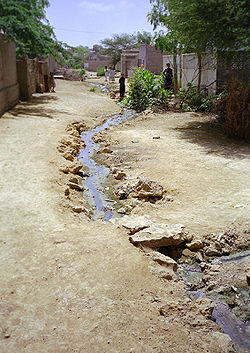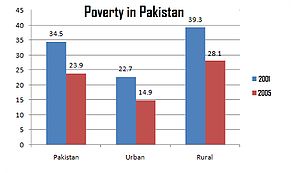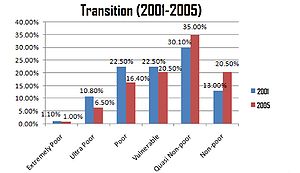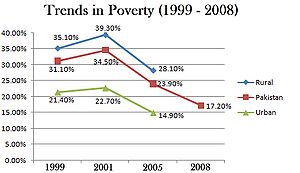
Poverty in Pakistan
Encyclopedia

Pakistan
Pakistan , officially the Islamic Republic of Pakistan is a sovereign state in South Asia. It has a coastline along the Arabian Sea and the Gulf of Oman in the south and is bordered by Afghanistan and Iran in the west, India in the east and China in the far northeast. In the north, Tajikistan...
to 40 million(www.pakistanandpakistanis.com) nearly one-quarter of the population is classified poor as of October 2006. As of 2007-08, 17.2% of the total population lived below the poverty line, which is the lowest figure in the history of Pakistan. The declining trend in poverty as seen in the country during the 1970s and 1980s was reversed in the 1990s by poor federal policies and rampant corruption. This phenomenon has been referred to as the poverty bomb. government of Pakistan with help from the International Monetary Fund
International Monetary Fund
The International Monetary Fund is an organization of 187 countries, working to foster global monetary cooperation, secure financial stability, facilitate international trade, promote high employment and sustainable economic growth, and reduce poverty around the world...
(IMF) has prepared an Interim Poverty Reduction Strategy Paper that suggests guidelines to reduce poverty in the country.
As of 2009, Pakistan's Human Development Index
Human Development Index
The Human Development Index is a composite statistic used to rank countries by level of "human development" and separate "very high human development", "high human development", "medium human development", and "low human development" countries...
(HDI) is 0.572, higher than that of nearby Bangladesh
Bangladesh
Bangladesh , officially the People's Republic of Bangladesh is a sovereign state located in South Asia. It is bordered by India on all sides except for a small border with Burma to the far southeast and by the Bay of Bengal to the south...
's 0.543, which was formerly a part of the country itself. Pakistan's HDI still stands lower than that of neighbouring India's at 0.612.
Incidences of poverty in Pakistan rose from 22–26% in the fiscal year 1991 to 32–35% in the fiscal year 1999. They have subsequently fallen to 25–26% according to the reports of the World Bank and the UN Development Program reports. These reports contradict the claims made by the Government of Pakistan that the poverty rates are only 23.1%. Furthermore, the poverty rate declined to 17.2% in 2007-08 according to the World Bank
World Bank
The World Bank is an international financial institution that provides loans to developing countries for capital programmes.The World Bank's official goal is the reduction of poverty...
.
According to the Human Development Index
Human Development Index
The Human Development Index is a composite statistic used to rank countries by level of "human development" and separate "very high human development", "high human development", "medium human development", and "low human development" countries...
(HDI), 60.3% of Pakistan's population lives on under $2 a day, compared to 75.6% in nearby India and 81.3% in nearby Bangladesh
Bangladesh
Bangladesh , officially the People's Republic of Bangladesh is a sovereign state located in South Asia. It is bordered by India on all sides except for a small border with Burma to the far southeast and by the Bay of Bengal to the south...
, and some 22.6% live under $1 a day, compared to 41.6% in India and 49.6% in Bangladesh
Wealth distribution in Pakistan is highly uneven, with 10% of the population earning 27.6% of income According to the United Nations
United Nations
The United Nations is an international organization whose stated aims are facilitating cooperation in international law, international security, economic development, social progress, human rights, and achievement of world peace...
Human Development Report
Human Development Report
The Human Development Report is an annual milestone publication by the Human Development Report Office of the United Nations Development Programme .-History:...
, Pakistan's human development
Human development (humanity)
Human development in the scope of humanity, specifically international development, is an international and economic development paradigm that is about much more than the rise or fall of national incomes. People are the real wealth of nations...
indicators, especially those for women, fall significantly below those of countries with comparable levels of per-capita income. Pakistan also has a higher infant mortality
Infant mortality
Infant mortality is defined as the number of infant deaths per 1000 live births. Traditionally, the most common cause worldwide was dehydration from diarrhea. However, the spreading information about Oral Re-hydration Solution to mothers around the world has decreased the rate of children dying...
rate (88 per 1000) than the South Asia
South Asia
South Asia, also known as Southern Asia, is the southern region of the Asian continent, which comprises the sub-Himalayan countries and, for some authorities , also includes the adjoining countries to the west and the east...
n average (83 per 1000).
Spatial distribution of poverty

Punjab (Pakistan)
Punjab is the most populous province of Pakistan, with approximately 45% of the country's total population. Forming most of the Punjab region, the province is bordered by Kashmir to the north-east, the Indian states of Punjab and Rajasthan to the east, the Pakistani province of Sindh to the...
also has significan gradients in poverty among the different regions of the province.

Poverty and gender
The gender discriminatory practices in Pakistani society also shape the distribution of poverty in the country. Traditional gender roles in Pakistan define the woman's place as in the home and not in the workplace, and define the man as the breadwinner. Consequently, the society invests far less in women than men. Women in Pakistan suffer from poverty of opportunities throughout their lives. Female literacy in Pakistan is 43.6% compared to Male literacy at 68.2%, as of 2008. In legislative bodies, women constituted less than 3% of the legislature elected on general seats before 2002. The 1973 Constitution allowed reserved seats for women in both houses of parliament for a period of 20 years, thus ensuring that women would be represented in parliament regardless of whether or not they are elected on general seats. This provision lapsed in 1993, so parliaments elected subsequently did nothave reserved seats for women. Reserved seats for women have been restored after the election of 2002 . Female labour rates in Pakistan are exceptionally low.
Economic and social vulnerability
| Administrative Unit | 1998 Census | 1981 Census | ||
|---|---|---|---|---|
| Both Sexes | Male | Female | ||
| Pakistan Pakistan Pakistan , officially the Islamic Republic of Pakistan is a sovereign state in South Asia. It has a coastline along the Arabian Sea and the Gulf of Oman in the south and is bordered by Afghanistan and Iran in the west, India in the east and China in the far northeast. In the north, Tajikistan... |
19.68 | 20.19 | 5.05 | 3.1 |
| Rural | 19.98 | 20.40 | 5.50 | 2.3 |
| Urban | 19.13 | 19.77 | 4.49 | 5.2 |
| Khyber Pakhtunkhwa | 26.83 | 27.51 | 2.58 | 2.2 |
| Rural | 28.16 | 28.64 | 4.00 | 2.0 |
| Urban | 21.00 | 22.34 | 0.74 | 3.7 |
| Punjab Punjab (Pakistan) Punjab is the most populous province of Pakistan, with approximately 45% of the country's total population. Forming most of the Punjab region, the province is bordered by Kashmir to the north-east, the Indian states of Punjab and Rajasthan to the east, the Pakistani province of Sindh to the... |
19.10 | 19.60 | 5.50 | 3.2 |
| Rural | 18.60 | 19.00 | 6.00 | 2.5 |
| Urban | 20.10 | 20.7 | 4.70 | 5.0 |
| Sindh Sindh Sindh historically referred to as Ba'ab-ul-Islam , is one of the four provinces of Pakistan and historically is home to the Sindhi people. It is also locally known as the "Mehran". Though Muslims form the largest religious group in Sindh, a good number of Christians, Zoroastrians and Hindus can... |
14.43 | 14.86 | 4.69 | 3.3 |
| Rural | 11.95 | 12.26 | 3.70 | 1.6 |
| Urban | 16.75 | 17.31 | 5.40 | 5.8 |
| Balochistan Balochistan (Pakistan) Balochistan is one of the four provinces or federating units of Pakistan. With an area of 134,051 mi2 or , it is the largest province of Pakistan, constituting approximately 44% of the total land mass of Pakistan. According to the 1998 population census, Balochistan had a population of... |
33.48 | 34.14 | 8.67 | 3.1 |
| Rural | 35.26 | 35.92 | 9.81 | 3.0 |
| Urban | 27.67 | 28.33 | 5.35 | 4.0 |
| Islamabad Islamabad Islamabad is the capital of Pakistan and the tenth largest city in the country. Located within the Islamabad Capital Territory , the population of the city has grown from 100,000 in 1951 to 1.7 million in 2011... |
15.70 | 16.80 | 1.70 | 10.7 |
| Rural | 28.70 | 29.40 | 8.20 | 13.5 |
| Urban | 10.10 | 11.00 | 0.80 | 9.0 |
| Unemployment Rate: It is the percentage of persons unemployed (those looking for work and temporarily laid off) to the total economically active population (10 years and above). Source: http://www.statpak.gov.pk/depts/pco/statistics/other_tables/unemployment_rates.pdf | ||||
"Vulnerability" in this case stands for the underlying susceptibility of economically deprived people to fall into poverty as a result of exogenous random shocks. Vulnerable households are generally found to have low expenditure levels. Households are considered vulnerable if they do not have the means to smooth out their expenses in response to changes in income. In general, vulnerability is likely to be high in households clustered around the poverty line. Since coping strategies for vulnerable households depend primarily on their sources of income, exogenous shocks can increase reliance on non-agricultural wages. Such diversification has not occurred in many parts of Pakistan, leading to an increased dependence on credit.
While economic vulnerability is a key factor in the rise of poverty in Pakistan, vulnerability also arises from social powerlessness, political disenfranchisement, and ill-functioning and distortionary institutions, and these also are important causes of the persistence of vulnerability among the poor.
Other causes of vulnerability in Pakistan are the everyday harassment by corrupt government officials, as well as their underperformance, exclusion and denial of basic rights to many in Pakistan. Also, lack of adequate health care by the state lead the poor to seek private sources, which are expensive, but still preferable to the possibility of medical malpractice
Medical malpractice
Medical malpractice is professional negligence by act or omission by a health care provider in which the treatment provided falls below the accepted standard of practice in the medical community and causes injury or death to the patient, with most cases involving medical error. Standards and...
and being given expired medicines in state run medical facilities. Also, the failure by the state to provide adequate law and order in many parts of the country is a factor in the rise of vulnerability of the poor.
Environmental issues
Environmental problems in Pakistan, such as erosion, use of agro-chemicals, deforestation etc. contribute to rising poverty in Pakistan. Increasing pollution contributes to increasing risk of toxicity, and poor industrial standards in the country contribute to rising pollution.Lack of adequate governance
By the end of the 1990s, the manner in which power is exercised in the management of a country's social and economic resources for development emerged as Pakistan's foremost developmental problem. Corruption and political instabilities such as various separatist movements in BalochistanBalochistan (Pakistan)
Balochistan is one of the four provinces or federating units of Pakistan. With an area of 134,051 mi2 or , it is the largest province of Pakistan, constituting approximately 44% of the total land mass of Pakistan. According to the 1998 population census, Balochistan had a population of...
and Waziristan
Waziristan
Waziristan is a mountainous region near the Northwest of Pakistan, bordering Afghanistan and covering some 11,585 km² . The area is entirely populated by ethnic Pashtuns . The language spoken in the valley is Pashto/Pakhto...
resulted in reduction of business confidence, deterioration of economic growth, reduced public expenditure, poor delivery of public services, and undermining of the rule of law. The perceived security threat on the border with India has dominated Pakistan's culture and has led to the domination of military in politics, excessive spending on defense at the expense of social sectors, and the erosion of law and order.
Pakistan has been run by military dictatorships for large periods of time, alternating with limited democracy. These rapid changes in governments led to rapid policy changes and reversals and the reduction of transparency and accountability in government. The onset of military regimes have contributed to non-transparency in resource allocation. In particular, the neglect by the Pakistani state of the Balochistan
Balochistan (Pakistan)
Balochistan is one of the four provinces or federating units of Pakistan. With an area of 134,051 mi2 or , it is the largest province of Pakistan, constituting approximately 44% of the total land mass of Pakistan. According to the 1998 population census, Balochistan had a population of...
and Khyber Pakhtunkhwa has rendered the region poverty-stricken http://www.wsws.org/articles/2005/apr2005/pakis-a14.shtml. Those who do not constitute the political elite are unable to make political leaders and the Government responsive to their needs or accountable to promises. Development priorities are determined not by potential beneficiaries but by the bureaucracy and a political elite which may or may not be in touch with the needs of the citizens. Political instability and macroeconomic imbalances have been reflected in poor creditworthiness ratings, even compared to other countries of similar income levels, with resulting capital flight and lower foreign direct investment inflows. The current government of Pakistan has professed commitments to reforms in this area.
In addition, Pakistan's major cities and urban centres are home to an estimated 1.2 million street children. This includes beggars and scavengers who are often very young. The law and order problem worsens their condition as boys and girls are fair game to others who would force them into stealing, scavenging and smuggling to survive. A large proportion consumes readily available solvents to starve off hunger, loneliness and fear. Children are vulnerable to contracting STDs such as HIV/AIDS, as well as other diseases.
Feudalism
Pakistan is home to a large feudal landholding system where landholding families hold thousands of acres and do little work on the agricultureAgriculture
Agriculture is the cultivation of animals, plants, fungi and other life forms for food, fiber, and other products used to sustain life. Agriculture was the key implement in the rise of sedentary human civilization, whereby farming of domesticated species created food surpluses that nurtured the...
themselves. They enlist the services of their serfs to perform the labor of the land. 51% of poor tenants owe money to the landlords. The landlords' position of power allows them to exploit the only resource the poor can possibly provide: their own labor.

Poverty and Support for Islamic Militancy
Poverty and the lack of a modern curriculum have proved destabilizing factors for Pakistani society that have been exploited by militant organizations banned by the government to run schools and produce militant literature. Though many madrassas are benign, there are those that subscribe to the radicalist branches of Sunni IslamIslam
Islam . The most common are and . : Arabic pronunciation varies regionally. The first vowel ranges from ~~. The second vowel ranges from ~~~...
,.
As a result, militant Islamic political parties have become more powerful in Pakistan and have considerable sympathy among the poor. This phenomenon is more pronounced in the North Western Frontier Province.
Inequality and natural disasters
The recent 2010 Pakistan floods2010 Pakistan floods
The 2010 Pakistan floods began in late July 2010, resulting from heavy monsoon rains in the Khyber Pakhtunkhwa, Sindh, Punjab and Balochistan regions of Pakistan and affected the Indus River basin. Approximately one-fifth of Pakistan's total land area was underwater, approximately...
have accentuated differences between the wealthy and poor in Pakistan. Abdullah Hussain Haroon, Pakistan's diplomat to the United Nations
United Nations
The United Nations is an international organization whose stated aims are facilitating cooperation in international law, international security, economic development, social progress, human rights, and achievement of world peace...
, has alleged that wealthy feudal warlord
Warlord
A warlord is a person with power who has both military and civil control over a subnational area due to armed forces loyal to the warlord and not to a central authority. The term can also mean one who espouses the ideal that war is necessary, and has the means and authority to engage in war...
s and landowners in Pakistan have been diverting funds and resources away from the poor and into their own private relief efforts. Haroon also alluded to was evidence that landowners had allowed embankments to burst, leading to water flowing away from their land. There are also allegations that local authorities colluded with the warlords to divert funds. The floods have accentuated the sharp divisions in Pakistan between the wealthy and the poor. The wealthy, with better access to transportation and other facilities, have suffered far less than the poor of Pakistan.
Verge of breakdown of the economy and subsequently of the country:
Around 95% of Pakistani citizens polled that they have a fear of complete breakdown of the country's economy which could ultimately lead to the break of the country.
As compared to China, the rate of of increase in poverty and unemployment is very high in Pakistan. Recently, pakistani media led a thorough coverage of how Pakistan's military was holding a large part of the pie of Pakistan's over all GDP, which has intensified the feeling of limited competition in Pakistani public.
External links
- Poverty in Pakistan (Broken link)
- Pakistan Poverty Assessment by the World Bank (Broken link)
- Causes of Poverty in Pakistan

